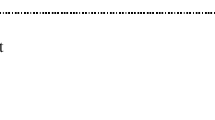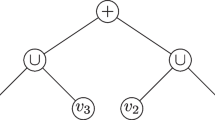Abstract
A function \({f : {\mathbb F}_{2}^{n} \rightarrow {\{0,1\}}}\) is triangle-free if there are no \({x_{1},x_{2},x_{3} \in {\mathbb F}_{2}^{n}}\) satisfying \({x_{1} + x_{2} + x_{3} = 0}\) and \({f(x_{1}) = f(x_{2}) = f(x_{3}) = 1}\). In testing triangle-freeness, the goal is to distinguish with high probability triangle-free functions from those that are \({\varepsilon}\)-far from being triangle-free. It was shown by Green that the query complexity of the canonical tester for the problem is upper bounded by a function that depends only on \({\varepsilon}\) (Green 2005); however, the best-known upper bound is a tower-type function of \({1/\varepsilon}\). The best known lower bound on the query complexity of the canonical tester is \({1/\varepsilon^{13.239}}\) (Fu & Kleinberg 2014).
In this work we introduce a new approach to proving lower bounds on the query complexity of triangle-freeness. We relate the problem to combinatorial questions on collections of vectors in \({{\mathbb Z}_D^n}\) and to sunflower conjectures studied by Alon, Shpilka & Umans (2013). The relations yield that a refutation of the Weak Sunflower Conjecture over \({{\mathbb Z}_{4}}\) implies a super-polynomial lower bound on the query complexity of the canonical tester for triangle-freeness. Our results are extended to testing k-cycle-freeness of functions with domain \({{\mathbb F}_p^n}\) for every \({k \ge 3}\) and a prime p. In addition, we generalize the lower bound of Fu and Kleinberg to k-cycle-freeness for \({k \geq 4}\) by generalizing the construction of uniquely solvable puzzles due to Coppersmith & Winograd (1990).
Similar content being viewed by others
References
Alon Noga (2002) Testing subgraphs in large graphs. Random Struct. Algorithms 21(3-4): 359–370 Preliminary version in Foundations of Computer Science’01
Alon Noga, Boppana Ravi B. (1987) The monotone circuit com plexity of Boolean functions. Combinatorica 7(1): 1–22
Noga Alon, Eldar Fischer, Ilan Newman & Asaf Shapira (2009). A Combinatorial Characterization of the Testable Graph Properties: It’s All About Regularity. SIAM J. Comput. 39(1), 143–167. Preliminary version in Symposium on Theory of Computing’06.
Alon Noga, Hod Rani, Weinstein Amit (2016) On Active and Passive Testing. Combinatorics, Probability & Computing 25(1): 1–20
Alon Noga, Shpilka Amir, Umans Christopher (2013) On sunflowers and matrix multiplication. Computational Complexity 22(2): 219–243 Preliminary version in CCC’12
Bateman Michael, Katz Nets Hawk (2012) New bounds on cap sets. J. Amer. Math. Soc. 25(2): 585–613
Behrend F. A. (1946) On Sets of Integers Which Contain No Three Terms in Arithmetical Progression. Proc. National Academy of Sciences USA 32(12): 331–332
Bhattacharyya Arnab (2013) Guest column: On testing affine invariant properties over finite fields. SIGACT News 44(4): 53–72
Arnab Bhattacharyya, Elena Grigorescu & Asaf Shapira (2015). A unified framework for testing linear-invariant properties. Random Struct. Algorithms 46(2), 232–260. Preliminary version in Foundations of Computer Science’10.
Arnab Bhattacharyya & Ning Xie (2015). Lower bounds for testing triangle-freeness in Boolean functions. Computational Complexity 24(1), 65–101. Preliminary version in SODA’10.
Christian Borgs, Jennifer T. Chayes, László Lovász, Vera T. Sós, Balázs Szegedy & Katalin Vesztergombi (2006). Graph limits and parameter testing. In Proceedings of the Thirty-Eighth Annual ACM Symposium on Theory of Computing, 261–270.
Henry Cohn, Robert D. Kleinberg, Balázs Szegedy & Christopher Umans (2005). Group-theoretic Algorithms for Matrix Multiplication. In Proceedings of the 46th Annual IEEE Symposium on Foundations of Computer Science, 379–388.
Coppersmith Don, Winograd Shmuel (1990) Matrix Multipli cation via Arithmetic Progressions. J. Symb. Comput. 9(3): 251–280 Preliminary version in Symposium on Theory of Computing’87
Dinur Irit, Safra Shmuel (2005) On the hardness of approximating minimum vertex cover. Annals of Mathematics 162(1): 439–485 Preliminary version in Symposium on Theory of Computing’02
Edel Yves (2004) Extensions of Generalized Product Caps. Des. Codes Cryptography 31(1): 5–14
Elkin Michael (2011) An improved construction of progression-free sets. Israel J. of Math. 184(1): 93–128 Preliminary version in SODA’10
Erdös P., Rado R. (1960) Intersection sets. J. London Math. Soc. 35: 85–90
Erdös Paul, Szemerédi Endre (1978) Combinatorial Properties of Systems of Sets. J. Comb. Theory, Ser. A 24(3): 308–313
Fox Jacob (2011) A new proof of the graph removal lemma. Annals of Mathematics 174(1): 561–579
Hu Fu & Robert Kleinberg (2014). Improved Lower Bounds for Testing Triangle-freeness in Boolean Functions via Fast Matrix Multiplication. In RANDOM, 669–676.
Oded Goldreich, Shafi Goldwasser & Dana Ron (1998). Property Testing and its Connection to Learning and Approximation. J. ACM 45(4), 653–750. Preliminary version in Foundations of Computer Science’96.
Green Ben (2005) A Szemerédi-type regularity lemma in Abelian groups. Geom. and Funct. Anal. 15(2): 340–376
Pooya Hatami, Sushant Sachdeva & Madhur Tulsiani (2013). An Arithmetic Analogue of Fox’s Triangle Removal Argument. CoRR arXiv:1304.4921.
Tali Kaufman & Madhu Sudan (2008). Algebraic property testing: the role of invariance. In Proceedings of the Fortieth Annual ACM Symposium on Theory of Computing, 403–412.
A. V. Kostochka (1997). A Bound of the Cardinality of Families not Containing \({\Delta}\)-Systems. In The Mathematics of Paul Erdös II, Algorithms and Combinatorics, volume 14, 229–235. Springer, Berlin.
Král’ Daniel, Serra Oriol, Vena Lluís (2009) A combinatorial proof of the Removal Lemma for Groups. J. Comb. Theory, Ser. A 116(4): 971–978
Král’ Daniel, Serra Oriol, Vena Lluís (2012) A removal lemma for systems of linear equations over finite fields. Israel J. of Math. 187(1): 193–207
Jacobus H. van Lint & Richard M. Wilson (2001). A course in combinatorics. Cambridge University Press, 2nd edition.
Yu-Ru Liu & Craig V. Spencer (2009). A generalization of Meshulam’s theorem on subsets of finite Abelian groups with no 3-term arithmetic progression. Des. Codes Cryptography 52(1): 83–91
Meshulam Roy (1995) On Subsets of Finite Abelian Groups with No 3-Term Arithmetic Progressions. J. Comb. Theory, Ser. A 71(1): 168–172
Razborov Alexander A. (1985) Lower bounds for the monotone complexity of some Boolean functions. Soviet Mathematics Doklady 31(2): 354–357
Ronitt Rubinfeld & Madhu Sudan (1996). Robust Characterizations of Polynomials with Applications to Program Testing. SIAM J. Comput. 25(2), 252–271. Preliminary version in SODA’92.
Salem R., Spencer D. C. (1942) On Sets of IntegersWhich Contain No Three Terms in Arithmetical Progression. Proc. National Academy of Sciences USA 28(12): 561–563
Asaf Shapira (2010). A proof of Green’s conjecture regarding the removal properties of sets of linear equations. J. London Math. Soc. 81(2), 355–373. Preliminary version in Symposium on Theory of Computing’09.
Andrew James Stothers (2010). On the complexity of matrix multiplication. Ph.D. thesis, The University of Edinburgh.
Sudan Madhu (2011) Guest column: Testing linear properties: some general theme. SIGACT News 42(1): 59–80
Virginia Vassilevska Williams (2012). Multiplying matrices faster than Coppersmith-Winograd. In Proceedings of the Forty-fourth Annual ACM Symposium on Theory of Computing, 887–898.
Author information
Authors and Affiliations
Corresponding author
Rights and permissions
About this article
Cite this article
Haviv, I., Xie, N. Sunflowers and Testing Triangle-Freeness of Functions. comput. complex. 26, 497–530 (2017). https://doi.org/10.1007/s00037-016-0138-7
Received:
Published:
Issue Date:
DOI: https://doi.org/10.1007/s00037-016-0138-7




